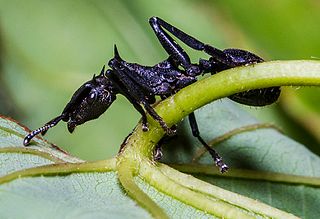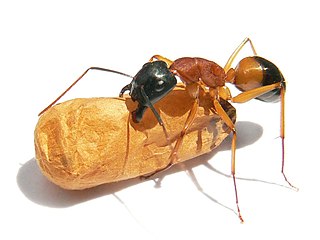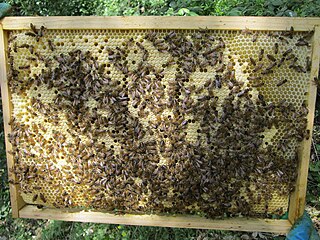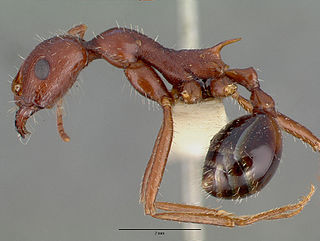
Trophallaxis is the transfer of food or other fluids among members of a community through mouth-to-mouth (stomodeal) or anus-to-mouth (proctodeal) feeding. Along with nutrients, trophallaxis can involve the transfer of molecules such as pheromones, organisms such as symbionts, and information to serve as a form of communication. Trophallaxis is used by some birds, gray wolves, vampire bats, and is most highly developed in eusocial insects such as ants, wasps, bees, and termites.

Atta is a genus of New World ants of the subfamily Myrmicinae. It contains at least 17 known species.
Autothysis or suicidal altruism is the process where an animal destroys itself via an internal rupturing or explosion of an organ which ruptures the skin. The term was proposed by Ulrich Maschwitz and Eleonore Maschwitz in 1974 to describe the defensive mechanism of Colobopsis saundersi, a species of ant. It is caused by a contraction of muscles around a large gland that leads to the breaking of the gland wall. Some termites release a sticky secretion by rupturing a gland near the skin of their neck, producing a tar effect in defense against ants.

Carpenter ants are large ants indigenous to many forested parts of the world.

Colobopsis saundersi, also called the Malaysian exploding ant, is a species of ant found in Malaysia and Brunei, belonging to the genus Colobopsis. A worker can explode suicidally and aggressively as an ultimate act of defense, an ability it has in common with several other species in this genus and a few other insects. The ant has an enormously enlarged mandibular gland, many times the size of other ants, which produces adhesive secretions for defense. According to a 2018 study, this species forms a species complex and is probably related to C. explodens, which is part of the C. cylindrica group.

Cephalotes is a genus of tree-dwelling ant species from the Americas, commonly known as turtle ants. All appear to be gliding ants, with the ability to "parachute" and steer their fall so as to land back on the tree trunk rather than fall to the ground, which is often flooded.

The banded sugar ant, also known as the sugar ant, is a species of ant native to Australia. A member of the genus Camponotus in the subfamily Formicinae, it was described by German entomologist Wilhelm Ferdinand Erichson in 1842. Its common name refers to the ant's liking for sugar and sweet food, as well as the distinctive orange-brown band that wraps around its gaster.

Corythomantis greeningi, occasionally called Greening's frog, is a venomous frog species in the family Hylidae endemic to eastern Brazil, where it lives in the Caatinga habitat. It is usually situated on vegetation, including in bromeliads, and on rock outcrops. Breeding occurs in temporary streams. Although suffering from habitat loss, it is not considered threatened by the IUCN. The specific name greeningi was in honour of Linnaeus Greening (1855–1927), an English businessman and naturalist known for his work on arachnids, reptiles and amphibians.

Lithodytes is a genus of frogs in the family of Leptodactylidae. It is monotypic, being represented by the single species, Lithodytes lineatus, also commonly known as the gold-striped frog or painted antnest frog. It is found in tropical South America where it lives in humid forests among the leaf litter. These frogs build foam nests at the edge of temporary pools, and the tadpoles develop within these. The frogs also associate with certain leafcutter ants and breed inside their nests without being attacked by the ants.
Myrmecia inquilina is a species of ant endemic to Australia in the subfamily Myrmeciinae, first discovered in 1955 and described by Athol Douglas and William Brown Jr. in 1959. These ants are large, measuring 21.4 millimetres (0.84 in). During the time of its discovery, Douglas and Brown announced M. inquilina as the first social parasite among the primitive subfamilies, and today it is one of the two known Myrmecia species to have no worker caste. Two host species are known, Myrmecia nigriceps and Myrmecia vindex. Aggression between M. inquilina and its host species does not occur, and colonies may only produce M. inquilina brood months after the inquiline queens begin to lay their eggs. Queens eat the colony brood or trophic eggs, and other Myrmecia species may kill M. inquilina queens if they reject them. Due to its restricted distribution and threats to its habitat, the ant is "vulnerable" according to the IUCN Red List.
Task allocation and partitioning is the way that tasks are chosen, assigned, subdivided, and coordinated within a colony of social insects. Task allocation and partitioning gives rise to the division of labor often observed in social insect colonies, whereby individuals specialize on different tasks within the colony. Communication is closely related to the ability to allocate tasks among individuals within a group. This entry focuses exclusively on social insects. For information on human task allocation and partitioning, see division of labour, task analysis, and workflow.

Eusociality is the highest level of organization of sociality. It is defined by the following characteristics: cooperative brood care, overlapping generations within a colony of adults, and a division of labor into reproductive and non-reproductive groups. The division of labor creates specialized behavioral groups within an animal society, sometimes called castes. Eusociality is distinguished from all other social systems because individuals of at least one caste usually lose the ability to perform behaviors characteristic of individuals in another caste. Eusocial colonies can be viewed as superorganisms.

Carebara diversa is a species of marauder ant widely distributed throughout Asia.

Globitermes sulphureus is a species of termite that is very common in central and southern Vietnam and also present in other areas of South East Asia, including Cambodia, Thailand, and Peninsular Malaysia. They live in nests made of earth that can be up to 1.5 m tall and can contain tens of thousands of individuals. Between five and 10 per cent of the population are soldier termites which can be recognised by their yellow abdomen and two large, curved mandibles. The termites use autothysis as a defense mechanism.
Colobopsis anderseni, synonym Camponotus anderseni, is a species of mangrove ant found in northern Australia.

Cephalotes texanus is a species of arboreal ant of the genus Cephalotes, characterized by an odd shaped head, and the ability to "parachute" by steering their fall if they drop off of the tree they're on. Giving their name also as gliding ants. The species is native of Texas and of the Mexican states of Nuevo Leon, San Luis Potosí and Tamaulipas. Their larger and flatter legs, a trait common with other members of the genus Cephalotes, gives them their gliding abilities.

Blepharidatta is a rare Neotropical genus of ants in the subfamily Myrmicinae. The genus, formed by predatory species whose small colonies nest in soil or leaf-litter, has up to seven species, but most of them are waiting for a formal taxonomic treatment or confirmation.

Novomessor cockerelli is a species of ant in the subfamily Myrmicinae. It is native to the deserts of the Southwestern United States and Mexico. It lives in large underground colonies in which there is a single queen. The worker ants leave the nest daily to forage for seeds, plant material and dead insects.

An ergatoid is a permanently wingless reproductive adult ant or termite. The similar but somewhat ambiguous term ergatogyne refers to any intermediate form between workers and standard gynes. Ergatoid queens are distinct from other ergatogyne individuals in that they are morphologically consistent within a species and are always capable of mating, whereas inter caste individuals, another class of ergatogynes, often are not. Ergatoids can exhibit wide morphological differences between species, sometimes appearing almost identical to normal workers and other times being quite distinct from both workers and standard queens. In addition to morphological features, ergatoids among different species can exhibit a wide range of behaviors, with some ergatoids acting only as reproductives and others actively foraging. Ergatoid queens have developed among a large number of ant species, and their presence within colonies can often provide clues on the social structures of colonies and as to how new colonies are founded. Without wings, almost all species of ants that solely produce ergatoid queens establish new colonies by fission.

Colobopsis is a genus of ants in the subfamily Formicinae. This genus was first described in 1861 by Mayr and contains 95 species. The type species is Colobopsis truncata.




















